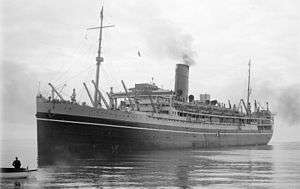SS Ranchi
SS Ranchi was a British passenger and cargo carrying ocean liner. During World War II, she served as an armed merchant cruiser HMS Ranchi.
 SS Ranchi after World War II (with aft funnel removed) | |
| History | |
|---|---|
| Builder: | Hawthorn Leslie and Company Newcastle upon Tyne |
| Launched: | 24 January 1925 |
| Acquired: | August 1939 |
| Commissioned: | 23 October 1939 |
| Decommissioned: | July 1947 |
| Out of service: | 16 March 1943 |
| Reclassified: | Armed merchant cruiser |
| Fate: | scrapped Newport, Monmouthshire, 1953 |
| General characteristics | |
| Tonnage: | 16,738 gross register tons |
| Length: | 547 ft (167 m) |
| Beam: | 71 ft (22 m) |
| Propulsion: | steam engine |
| Speed: | 17 kn (31 km/h; 20 mph) |
| Armament: |
|
P&O career
SS Ranchi was built for the Peninsular & Oriental Steam Navigation Company (P&O) by Hawthorn Leslie & Co. at Newcastle Upon Tyne, England and was launched on 24 January 1925. Her gross registered tonnage was 16,650, her length was 547 feet and her beam 71 feet. She was one of the P&O 'R' class liners from 1925 that had much of their interiors designed by Lord Inchcape's daughter Elsie Mackay.[1]
Named after Ranchi, now the capital city of Jharkhand state in eastern India, she sailed on a regular route between England and Bombay, India. Later she sailed to the Far East. She carried 600 passengers.
Second World War
Ranchi was requisitioned into the Royal Navy on 27 August 1939 (at the onset of World War II) and commissioned on 23 October 1939 as the armed merchant cruiser HMS Ranchi (Pennant F15). As an armed merchant cruiser, her gross registered tonnage was 16,738.
Her sister ships SS Rawalpindi, SS Rajputana and SS Ranpura were also converted to armed merchant cruisers. Except for small corvettes, the converted passenger ships like HMS Ranchi were the only armed protection for most of the early convoys. With their six-inch guns, they were the only escorts that could engage German surface ships. Very few convoys received the protection of the larger cruisers or battleships.
From October 1939 until February 1942 she served the East Indies Station; from March 1942 until January 1943 she was part of the Eastern Fleet (Indian Ocean). She was returned and used as a troopship by the Ministry of War Transport (MoWT) on 16 March 1943. 'Ranchi' sailed from the Firth of Clyde, 15 November 1943 in convoy KMF26. In early 16 December German Heinkels attacked from their base at Rhodes. One bomb hit the fo'c'sle of the 'Ranchi' and penetrated the troops' heads and went out through the ship's side, before exploding. Only one man was killed, and the ship limped on to Alexandria, Egypt, for repairs.[2]
Two months after the end of World War II in the Pacific, in October 1945 Ranchi sailed from Singapore to Southampton carrying amongst others released prisoners of war and civilian internees recently liberated from Japanese camps. Hilda Bates, who had been interned in Batu Lintang camp at Kuching, Borneo, wrote on 23 October 1945: "We are now speeding towards England aboard the S.S. Ranchi, which is packed with troops and other ex P.O.W.s like ourselves ... In our cabin there are twelve women, - five of who[m] are returning home as widows."[3]
Post-war career
On 18 July 1947 Ranchi was returned to her owners, P&O. Ranchi was used as an emigrant ship between June 1948 and 1952, when she completed 15 voyages from England to Australia. The shipping nominal rolls are held at the Victorian Public Records Office, Melbourne, Australia. Her first post war voyage was from Tilbury Docks on 17 June 1948, although her journey was delayed into Fremantle as there were rough seas off the coast of Western Australia. During her refit at Southampton and London Docks, her second funnel was removed and she also retained her traditional P&O colours of a black funnel and cream hull.
SS Ranchi was broken up at Newport, Monmouthshire in 1953.
SS Ranchi in popular culture
The P&O liner SS Canberra doubled for Ranchi in the final episode of Tenko, the popular BBC TV series about women civilian internees in the Far East in 1984.[4]
The Blue Lotus, fifth volume of the comic book series The Adventures of Tintin, features an ocean liner named SS Ranchi which operates in Asia.
British entertainer Cliff Richard travelled to England aboard Ranchi when his family left India in 1948.
Evelyn Waugh travelled on Ranchi in 1929 from Port Said to Malta as described in his travel book Labels.
SS Ranchi features in the "Inheritance of murder" developed by Cosykiller. Marie Jones travels to india on board this vessel.
References
- P & O Line Ships (and technical data) from 1920 to 1930 Archived 30 January 2010 at the Wayback Machine
- http://www.convoyweb.org.uk
- Ooi, Keat Gin, 1998, Japanese Empire in the Tropics, 631
- "Canberra 1961-1997". Archived from the original on 3 March 2016.
Bibliography
- Osborne, Richard; Spong, Harry; Grover, Tom (2007). Armed Merchant Cruisers 1878–1945. Windsor, UK: World Warship Society. ISBN 978-0-9543310-8-5.